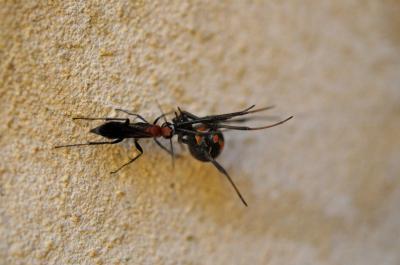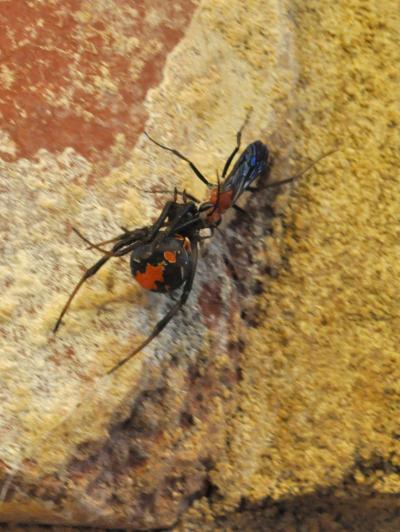University of Adelaide researchers say a small wasp that scientists had forgotten about for more than 200 years is now making a name for itself – as a predator of Australia's most common dangerous spider, the redback.
The wasp (Agenioideus nigricornis) was first described scientifically in 1775 by Danish entomologist Johan Christian Fabricius, thanks to samples collected in Australia during Captain Cook's first great voyage (1768).
"Since then, scientists have largely forgotten about the wasp," says Professor Andy Austin from the University of Adelaide's Australian Centre for Evolutionary Biology & Biodiversity. "It is widespread across Australia and can be found in a number of collections, but until now we haven't known the importance of this particular species."

This shows a redback spider-hunting wasp (Agenioideus nigricornis) dragging its paralyzed prey back to its nest.
(Photo Credit: Photo by Florian and Peter Irwin.)
The wasp is now being dubbed the "redback spider-hunting wasp" after a family in Beaconsfield, Western Australia, discovered one of them with a paralyzed redback spider in their back yard.
Florian Irwin, then aged 9, spotted the wasp dragging the spider several meters to its nest, and his father, Dr Peter Irwin, photographed the event and kept the specimens. Peter, who is an Associate Professor at Murdoch University, contacted the Western Australian Museum about the discovery; the Museum alerted Professor Austin and research fellow Dr Lars Krogmann at the University of Adelaide.
"The Museum knew we were doing research into the Agenioideus, which belongs to the family Pompilidae, the spider-hunting wasps. Little is known about them, despite various species of Agenioideus being distributed throughout the world," Professor Austin says.
"We're very excited by this discovery, which has prompted us to study this species of wasp more closely. It's the first record of a wasp preying on redback spiders and it contributes greatly to our understanding of how these wasps behave in Australia."

This shows a redback spider-hunting wasp (Agenioideus nigricornis) dragging its paralyzed prey back to its nest.
(Photo Credit: Photo by Florian and Peter Irwin.)
With a body less than a centimeter in length, an adult redback spider-hunting wasp is no bigger than its prey. It stings and paralyses the redback spider and drags it back to its nest, where the wasp lays an egg on it. The spider remains alive but is paralyzed. Once the egg hatches, the larval wasp feeds on the spider.
The redback spider (Latrodectus hasselti) is an Australian relative of North America's black widow spider.
"The redback spider is notorious in Australia, and it has spread to some other countries, notably Japan and New Zealand. Redbacks are one of the most dangerous species in Australia and they're mostly associated with human dwellings, which has been a problem for many years," Professor Austin says.
"The redback spider-hunting wasp is doing its part to keep the population of redback spiders down, but it doesn't hunt all the time and is unlikely to completely eradicate the spiders."

This is a Agenioideus nigricornis, now also known as the redback spider-hunting wasp.
(Photo Credit: Photo by Dr Lars Krogmann.)
Source: University of Adelaide